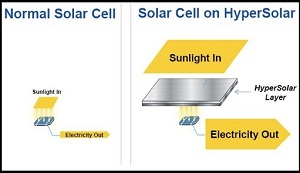New tech increases sunlight hitting PV by 300 percent
 Most companies in the solar marketplace are working to increase the efficiency of their solar cells. And a growing number are working to boost the amount of sunlight that hits the photovoltaics themselves.
Most companies in the solar marketplace are working to increase the efficiency of their solar cells. And a growing number are working to boost the amount of sunlight that hits the photovoltaics themselves.
One such company, HyperSolar, Inc.(OTCBB:HYSR), recently announced its first prototype design, which can increase the amount of sun hitting a silicon photovoltaic by 300 percent through a magnifying top sheet made of inexpensive plastics.
While many solar concentrators are large and bulky, focusing sunlight on small, high-efficiency cells, the HyperSolar technology is a centimeter-thick. It’s a plastic top coat for a photovoltaic module and a solar concentrator that acts as an impressive magnifying glass for solar cells. The prototype design can focus roughly 300 percent more sunlight on photovoltaic cells, allowing manufacturers to reduce the amount of solar cells on a module by about 75 percent while producing the same power output, reducing the overall cost of the module because of the lowered amount of expensive photovoltaic materials.
“We’re not changing the efficiency of the cell or getting more power out of the panel, but we’re getting more power out of the cell,” said HyperSolar CEO Tim Young.
Other companies are developing concentrating solar devices for solar cells, but they often focus on specially designed high-efficiency photovoltaic cells and can concentrate the amount of sun hitting the cell about a thousand times.
“We’re focused on generating more power out of traditional crystalline cells that represent more than 80 percent of the market. Today’s solar cells can handle up to five to six times of [sunlight] concentration,” he said. “When we’re successful in crystalline, we’ll look to tackle other markets out there,” Young said. “Thin-film is about 10 percent of the market or less. That’s why we’re focused on silicon.”
Still, HyperSolar is just one of many companies seeking to apply innovative top-coat technologies to normal photovoltaics.
This past summer SolOptics, a division of GenieLens Technologies, LLC., said its thin-film coating for photovoltaics, called Fusion, was proven by the National Renewable Energy Laboratory to improve photovoltaic efficiency by 10 percent.
“Fusion uses a surface geometry to improve the path length of rays of light through PV absorbing materials, increase total internal reflection to allow for second or additional chances of light absorption, and reduces reflection from the sun facing surface of a PV panel,” said SolOptics spokesperson Elana Rose. “We have initiated discussions with numerous potential strategic partners for the purpose of manufacturing, distributing and selling Fusion on a global scale.”
HyperSolar isn’t at that point yet, Young said.
“We expect to complete the prototype in the next 90 days,” he said. “Once this prototype is built, we will be looking for a panel manufacturer to partner with to build a commercial prototype. And we do have a vendor that was helping us build a prototype.”
Image courtesy of HyperSolar.



